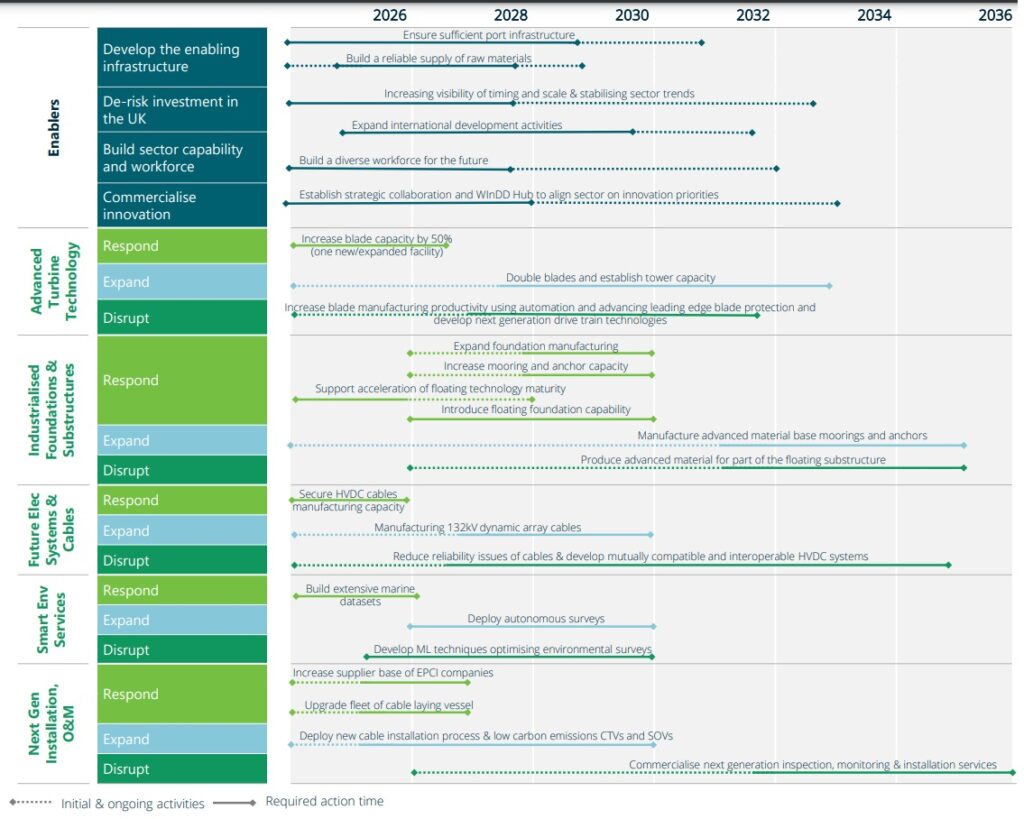Plan released to triple offshore wind supply chain and achieve £25bn economic boost by 2035

This post was originally published on this site
A roadmap to tripling the UK’s offshore wind manufacturing capability and providing a £25bn boost to the economy by 2035 has been released by key players in the nation’s offshore wind industry.
RenewableUK, the Offshore Wind Industry Council, the Crown Estate and Crown Estate Scotland have put together the Industrial Growth Plan (IGP), which will harness the success story of UK offshore wind and “firmly establish the UK as a leader in a surging global market”.
The offshore wind industry in the UK currently employs 32,000 people and each new GW of offshore energy adds £2bn to £3bn to the economy, according to the IGP. With the UK aiming to have 50GW of offshore wind capacity by 2030, the industry is already projected to reach over 100,000 jobs by 2030 and provide £92bn in economic opportunities by 2040.
However, by following the IGP, there could be an additional 10,000 jobs a year and a further £25bn in GVA for the economy by 2035, it is claimed. This will require an acceleration of wind deployment to achieve 5-6GW of new offshore wind capacity annually.
Government has said that the IGP “will work with [its] £1bn Green Industries Growth Accelerator to make sure the UK can build out the supply chain”.
Global technology leader
Key to the IGP is ensuring that the UK becomes a “global technology leader” in five key offshore wind technologies: advanced turbines, industrialised foundations and substructures, future electrical systems and cables, smart environmental services and next generation installation and operations and maintenance (O&M).
As well as the employment and GVA boosts, this will triple the UK’s manufacturing capability and double its research and development investment and output, according to the IGP.
There are three significant enablers for this. First is an Industrial Growth Fund that is a collaborative, joint-industry fund to support the IGP delivery and investment over a five year period. Next is an Offshore Wind Innovation Development and Demonstration Hub for late stage testing of new offshore wind technologies. Additionally, as part of this hub, there must be an Advanced Turbine Technology Institute.
This will all be supported by a new IGP Delivery Body that expands the partnership between governments, industry investors, technology, developers and wider stakeholders.
This delivery body must “own” the IGP by investing, monitoring and reporting progress, while refreshing the plan at regular intervals. It will also align strategic funding across key funding bodies and stakeholders. Its remit will also involve championing the UK as a leading destination for investment.
Enabling the plan
According to the IGP, for the UK to realise the economic and social potential for offshore wind, targeted investment is required to address the constraints in supply chain and develop UK capability and capacity.
A “make or buy prioritisation assessment” must be conducted considering inputs from the sector’s previous Supply Chain Capability Assessment study. The outcomes of this will inform the priorities for the UK.
The actions and objectives of these priorities must respond to the current supply chain constraints, expand the UK’s capability and capacity to capture international market share and disrupt the status quo to address current market challenges and put the UK at the centre of offshore wind advancement.
Execution will require collective work across the sector, enabled by an environment to succeed and the new delivery body.
The case
The case for action is clear, the IGP argues, as there is set to be a global expansion of offshore wind which will be a competition that presents huge growth opportunity.
Global offshore wind capacity is expected to triple by 2035 and the UK has 7% of the pipeline. There is a £270bn serviceable domestic market and a £1,000bn serviceable export market to 2035.
The estimated spend on global offshore wind projects to 2050 is £8,000bn.
The scale up will be enormous. The IGP expects an average of 300 wind turbine generators will be needed annually in the UK to 2030 to meet demand. The need for cables in Europe alone will expand by 14 times by 2030 and the UK workforce will quadruple by 2050.
With 100GW of global offshore wind capacity expected by 2035, the UK can lead tech innovation. Consolidating and expanding on its position as a frontrunner in the industry through the IGP can ensure that it leads the way to 11% reduction in levelized cost of electricity (LCOE) through O&M improvements and reduce climate change impact by 45% through use of new materials.
Next steps
The industry will now take forward its proposals to set up the IGP Delivery Body in collaboration with key partners. This body will ensure that best use is made of funding provided by the industry, the Government’s Green Industry Growth Accelerator (GIGA) fund, The Crown Estate’s Supply Chain Accelerator, Scottish Government funding and other sources.
In order to meet the ambition of the IGP, it is intended for the delivery body to be established by the end of 2024.
The IGP can be read in full here.
The outline timeline for the delivery of the IGP is below.
RenewableUK chief executive Dan McGrail said: “Our Industrial Growth Plan is the deepest dive ever into the offshore wind supply chain, identifying the highest-value components and services which the UK should focus on to get the biggest economic bang for our buck from future wind farm development.
“By using this as a blueprint to work closely with all our partners in the sector, we can triple the size of that supply chain, ramp up our offshore wind capacity significantly and secure a huge increase in jobs, all within the next 10 years.”
Energy Security Secretary Claire Coutinho said: “Britain’s windswept shorelines give us a competitive advantage in the global race for energy. That’s why, since 2010, Britain has been second only to China in building new offshore wind.
“The plans set out by industry today will work with our £1bn Green Industries Growth Accelerator to make sure the UK can build out the supply chain – including the turbine blades and high-voltage cables that we will need to produce cheaper, cleaner, more secure energy.”
Offshore Wind Industry Council (OWIC) co-chair Richard Sandford said: “OWIC stands firmly behind the plan to accelerate the growth of our domestic offshore wind supply chain, building on the successes already delivered through funding the Offshore Wind Growth Partnership, and taking full advantage of Britain’s global leadership in offshore wind. We look forward to working with colleagues across Government, The Crown Estate, Crown Estate Scotland and the wider industry, as we implement the strategic measures set out in the Industrial Growth Plan. These will help us to build up our world-class supply chain with new facilities in the UK, providing innovative products and highly-prized expertise for projects here and all over the world in an intensely competitive multi-billion pound export market.”
The Crown Estate managing director, marine Gus Jaspert said: “To truly make the most of the shift to renewable energy, we must also view the UK’s energy transition as an economic and jobs transition. Our offshore wind industry is already world leading but as demand for wind technology increases further, both nationally and on a global level, the UK must be on the front foot investing in and developing its supply chain to accelerate growth within the sector.
“Establishing this supply chain will take co-ordination and collaboration across UK governments and industry, and the IGP provides the detail needed to target those areas where we can have the biggest impact. As an early action, The Crown Estate is establishing a £50M Supply Chain Accelerator to catalyse early-stage investment, with an initial £10M pilot fund launching this summer to support supply chain opportunities created through the Celtic Sea Leasing Round 5 and a further £40M earmarked aligned to the IGP.”
Crown Estate Scotland interim director of marine Sian Wilson said: “The success of recent leasing rounds in Scotland demonstrates the huge appetite to ensure that offshore wind, especially floating turbines, lie at the heart of the just transition to net-zero. This Industrial Growth Plan is central to coordinating effective collaboration of innovation and investment effort, all of which are important for successfully developing and delivering a supply chain system which can fulfil the needs of ScotWind and other offshore leasing programmes, which are essential to achieve a green energy future.”
Like what you’ve read? To receive New Civil Engineer’s daily and weekly newsletters click here.






Responses